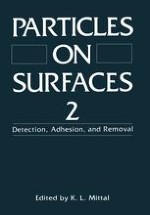1989 | OriginalPaper | Buchkapitel
The Role of Infrared and Raman Microspectroscopies in the Characterization of Particles on Surfaces
verfasst von : Kenneth J. Ward, David R. Tallant
Erschienen in: Particles on Surfaces 2
Verlag: Springer US
Enthalten in: Professional Book Archive
Aktivieren Sie unsere intelligente Suche, um passende Fachinhalte oder Patente zu finden.
Wählen Sie Textabschnitte aus um mit Künstlicher Intelligenz passenden Patente zu finden. powered by
Markieren Sie Textabschnitte, um KI-gestützt weitere passende Inhalte zu finden. powered by
The nondestructive identification of particles on surfaces can be accomplished quickly and definitively using vibrational microspectroscopy. Both Fourier-transform infrared (FT-IR) and Raman microspectroscopies are vibrational spectroscopy methods which are now commercially available. These two techniques arfe strongly complementary for several reasons. Both methods detect vibrational energies between atoms in molecules. However, the quantum mechanical selection rules differ such that infrared spectroscopy is more sensitive to asymmetric molecular distortions and Raman spectroscopy to symmetric modes. This means that weak bands in infrared spectra are often strong in Raman spectra and vice versa. Infrared spectroscopy directly measures absorption of incident infrared radiation. However, Raman spectroscopy observes the same vibrational frequencies by measuring the differences in energy between incident and scattered visible light. This means that infrared microspectroscopy has a diffraction limitation of about 10 micrometers while the diffraction limit for Raman microspectroscopy is near 1 micrometer, so Raman microspectroscopy can be used for smaller particles.
